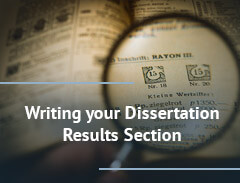Writing your Dissertation Results Section
The result section of any original paper reporting investigative work is the part where the author details his or her findings. Data like measurements taken, surveys or everything else that’s similar is all gathered, organized and shown to the reader in a way that makes it simple to grasp its meaning.
Your results section should be a short presentation where you have the chance to outline your research-based findings, while only giving the reader direct information and the results of any statistical analysis you’ve made. It should basically be straightforward and dry, containing no interpretation of the mentioned data, no detailed meaning of the found results or the methods by which they were obtained. An in-depth view of those should be found in other sections of your work, like Discussion and Methodology.
Starting out
Organizing the information you have should be the first step toward writing a proper Results section. Knowing what parts of the collected data are important to the overall discussion and which are not so important is a crucial step you must take, as everything in the Results section should be directly linked to the main question at the base of your research. Taking the time to properly sort your data is also important because the most relevant pieces of information need to take priority in your Results section, so a first step would be properly organizing all available information.
What needs to be included in the Results section
Due to the risk of overwhelming the reader with too many numbers and statistics, your dissertation rarely needs to include pure unedited data. It’s your job as the author to go through all available information and only select the parts that are directly relevant to the central question of your research. Also, remember that this goes both ways, as it is your obligation to present both data supporting your views on the matter and data that contradicts your point.
To make sure you don’t leave anything out, make a list of the ideas you’d like to put forward and make sure all data presented is directly linked to those ideas, as all information that is irrelevant to your research questions should promptly be left out. If however, some raw information is strictly necessary, it’s best to include it in your paper’s appendix instead of the main body.
Organizing your data
Making your Results section easy to read is the most important part. There is a lot of information that needs to be crammed into a relatively small space, with the help of a few graphics and quotes. While the majority of Results sections contain tables, figures, and text, it’s a good idea for the graphics to go first, as the rest of the section could be built around them.
Adding subheadings that help center your information around certain general themes or ideas can help a reader browse quickly through the entire paper. If surveys are a part of your research, for example, subheadings related to specific sample groups could be grouped together. Or if your main hypothesis is divided into different parts, your results sections could be organized in such a way that each result addresses a different part specifically. Usually tables and figures dictate subheadings usage.
Your results section should list its most relevant and significant findings first, leaving the less relevant ones closer to the end, no matter what the subheadings are. The main reason for it is that people reading the work will more often than not have a brief look at the paper, quickly browsing for the main parts instead of reading it in its entirety. So having the most important results first is a way to make sure most readers will at least take away the most important points of your dissertation.
Each part should start with describing the sample, along with its size and a clear reason for either missing or excluded pieces of information. Then, relevant descriptive statistics like range, frequency, mean, median or others should be included, and after that, you should detail any performed statistical analyses such as tests, ANOVA, etc. If you included a qualitative study, it should be backed up with relevant information like quotes that will prove vital in the overall discussion.
Figures and tables
A well-made figure or table does an excellent job of conveying more information that’s relevant to the topic in less space than traditional text would take to accomplish the same task, leading to a Results section that is neat looking and to the point.
Tables
Tables are, essentially, lists organized in rows and columns that outlay numerical values, and they are widely used to help the reader process and understand certain derived pieces of data. A table should be used if the author has more information than a simple text would be able to properly cover. A general rule to determine if that’s the case is not creating any table that contains less than nine cells in total. So for example, if the data you need to submit can fit in less than a space of three columns and three rows, it would be recommended that you present it as text.
Figures
Figures can mean any pictures, charts, maps, graphs or any kind of illustrations that you want to include in the Results section. Every figure should come with a brief description below it. A photo, for example, should come with the reason why it is there, as well as its source. The most common figures in the Results section are, without a doubt, graphs, as they do a good job in showing connections between data.

Although the choice of using tables or figures is up to the author, a good general recommendation is not using tables when trying to prove a connection between certain groups of values. If you are writing a paper dedicated to a specific treatment, tables would be used to discuss its cumulative effects, while figures would be used to show each treatment effect variation week by week. Also, avoid adding the same data more than once; this should help keep the Results section brief. In other words, if some data is included in a table, you don’t need to show it in a graph, and the other way around.
Graphics formatting is also important. Rules for formatting tables and figures vary with each style guide; however, generally, tables have their name and number posted above them and any notes explaining them underneath. Figures, on the other hand, have the numbers, names and descriptions all posted underneath and they’re both referred to by their numbers in the main text.
Writing tips
The writing in the results section should be kept as simple as possible. Past tense should be used, along with an active voice (as much as possible), although it’s understandable that certain parts will require the passive voice usage. Also, it’s safe to assume that the readers will have a basic understanding of the subject at hand, so there’s no need to overcrowd your work with explanations regarding basic statistics or terms that you use in your work. If however, an unusual statistical method or model is used, its explanation should be included in the Methodology section.
Although many students are tempted to add explanations or introductory notes to the section, a direct rendition of available data is usually the most recommended approach. This is an example of a text that contains too many useless words and offers a subjective view of the presented data:
- “It’s obvious from the table that the second group is a superior model for measuring student performance. Test scores from the first group show an average of 62 on the test, while the second group scored an average of 87, proving that superior preparation leads to better test results.”
- “Students in the second group had better results than those in the first group. While the first group scored an average of 62, the second group scored 12.5% better, meaning an average of 87.”
Keeping it short is vital. If tables and figures are the main components of the results section, repeating all that info in a text form is redundant. What you can do through text, though, is pinpointing the most important pieces of data from the tables and figures and using this text to emphasize their importance and relevance to the central idea. Also, all tables and figures included should always be referred to in the text - at least once. A proper context is needed for all included figures, and although no direct interpretation of the data is included in the Results section, the reader must know exactly what he or she is looking at, why it is presented to them, and what it means for the central theme of the paper.
There is no need for a conclusion to the Results section, as you can go directly to the Discussion chapter after completing it.
Next, do not forget that writing a Results section of your dissertation is still a very time-consuming task. Even though it may seem that most of the work has already been done, it would still be unwise to underestimate this section.
The last and probably the most important tip would be to carefully go over your entire dissertation again - after you finish the results section. Take a break (up to a couple of days if the time allows it) and come back to your work with a fresh eye. On this stage, it is vital to double check if all the data in your tables, graphs, and figures were properly referenced in the text. Also, you might want to take another critical look at your paper logic in general to make sure everything is clear and to the point.





